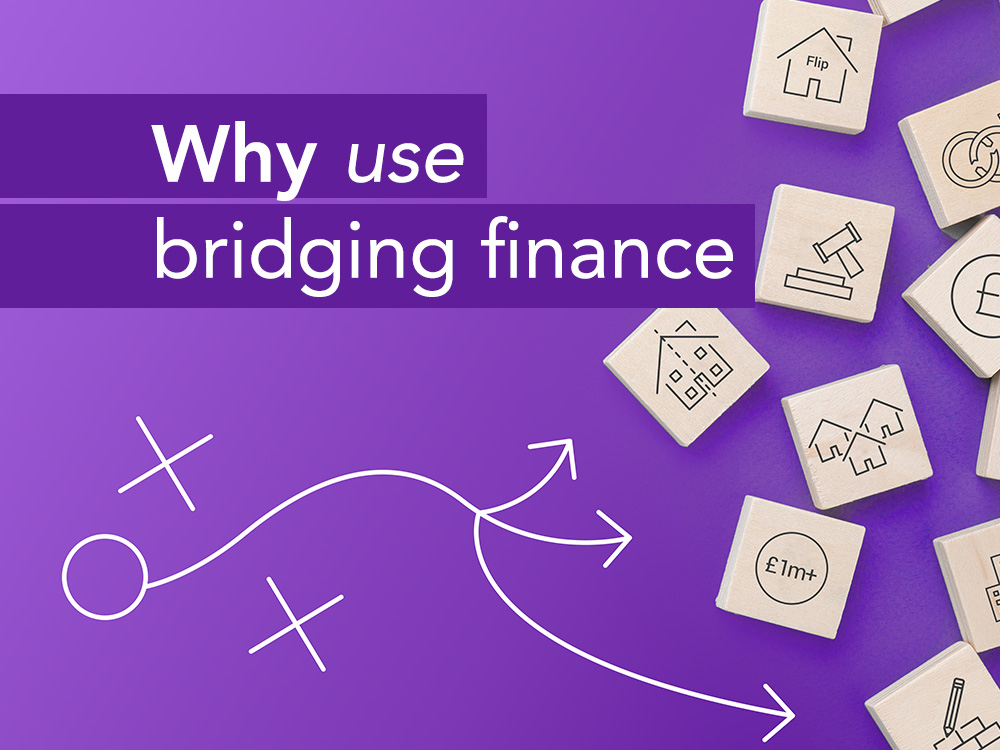Why use bridging finance?
As the popularity of bridging finance has increased, so too has the spread of uses that borrowers have found for it.

Maintaining a property chain
This is the most basic use of bridging finance, helping homeowners to move by smoothing out the period between buying and selling. In many cases, sellers are keen to conclude a deal quickly, so that they can get on with buying another property. So they may decide to accept an offer from a buyer who is in a position to pay quickly.
As a result, if you need to sell your property in order to afford to buy another one, you could be at a disadvantage. So bridging finance allows you to step in with a strong offer, promising to conclude a quick sale, while the sale of your existing property goes on in the background.
The great thing about using bridging finance in this situation is that, in the majority of cases, you’ll only need to borrow money for a short time – say two or three months. The interest you’ll have to pay on bridging finance for this period will be relatively insignificant, compared with the advantage of securing the property you wanted.
Buying an investment property
In the UK, hundreds of thousands of people invest in property to earn income, either as their principal job or as a side-line. Bridging finance can be extremely helpful to property investors. For example:
- To buy a property at below market value, refurbish it and sell it quickly for a profit. This is commonly known as flipping property.
- To buy a property and then make structural changes to it, such as adding a new extension, loft conversion, converting a large house into flats or an HMO, or a church or office into residential units, before selling.
- To buy short leasehold flats, then gain a new lease extension and refinance through a traditional mortgage, a buy-to-let mortgage, or to sell.
- To buy a dilapidated or otherwise ‘unmortgageable’ property, completing works to bring it up to a habitable standard, then to let it out or sell it. For example, if a property has no bathroom or kitchen, traditional mortgage providers are unlikely to offer funding.
Other examples of unmortgageable properties include ‘non-standard’ builds, such as glass, concrete, wood, metal or those with a thatched roof. These are much harder to get a mortgage for and subsequently are harder to sell. But bridging finance providers may still be able to help.
Buying property at auction
This is a specialist area, where bridging finance can be extremely helpful. By their nature, auctions require quick decision-making and immediate commitment of funds. Mortgage providers will not agree to extend funds for a property before they can see any details. And since buyers at auction sales have to pay 10 per cent of the sale price on the spot, followed by the outstanding amount within 28 days, there simply isn’t time to arrange a traditional mortgage.
The penalties for pulling out of an auction sale are pretty severe. You lose your 10 per cent deposit and the seller can pursue you for additional damages. So there’s a high degree of motivation to arrange finance in good time.
Bridging loans are ideal to meet auction sale requirements since the majority of the sale price can safely be advanced by the bridging finance company, using the property brought at auction as collateral. Once the sale is complete, the buyer can arrange longer-term funding at their leisure or renovate the property and sell it in time to repay the bridging loan.
Paying an unexpected bill
From time to time, we’re all faced with unexpected bills. Sometimes, these can be extremely high. For example, if a relative dies and leaves you a valuable property, you may face a large inheritance tax bill, to be paid immediately. What if the property isn’t ready to sell? Bridging finance can help to cover the period between paying the tax and receiving money from selling the property.
Equally, if you have a large but unexpected income tax, corporation tax or VAT bill, bridging finance can be very useful. While you work out how to deal with this liability over the longer term – by taking out a second mortgage, perhaps, or selling an asset – you can take out bridging finance, giving you time to reach the best solution.
Buying assets that traditional lenders won’t cover
High Street banks and building societies have quite strict lending criteria, which can put borrowers into difficult positions. If you own a property in the UK, for example, and you want to buy a holiday home overseas, banks and building societies may refuse to lend to you. A bridging loan can enable you to buy the overseas property.
Investors may want to buy shares in a business, anticipating that they will rise in value. They need access to funds quickly to take advantage of this opportunity, but traditional lenders may be reluctant to help them.
The Association of Short-Term Lenders recounts the story of an artist who needed to buy a large quantity of gold, to fulfil a sculpture commission for a wealthy Middle Eastern client. They turned to bridging finance for help.
For property development
If you own a small building company, you want to be able to draw down funds quickly and without complex legal arrangements. You may have a portfolio of properties with a substantial value, but that may not help you to raise funds from traditional lenders. Instead, builders in this position often form relationships with bridging finance companies to call on short-term funding quickly and flexibly.
In contrast to many forms of borrowing, bridging finance typically doesn’t charge penalties for early repayment, providing further flexibility and convenience for borrowers such as property developers and builders.
For business development
Business owners are often faced with decisions that require fast responses. A rival company comes up for sale – do they want to acquire it? An ideal office space becomes vacant – should they lease it? A large amount of raw material or an expensive piece of machinery becomes available at a bargain price, but only for a limited period – should they buy it? A partner announces that they wish to retire (or even more dramatically, dies) – does the other partner want to buy out their share of the company?
In each of these cases, the business owner can only act if they have the resources to do so. The company may be very profitable, but not have large amounts of capital on hand.
Bridging finance can step in to enable the business owner to take advantage of a situation with a short window of opportunity, potentially yielding rich rewards over time.
Stephen Clark at bridging finance broker Finbri comments:
“The great majority of our clients are investors seeking finance to acquire new properties, but the make-up of bridging demand is certainly changing and becoming more diverse. It goes to show how far the sector has matured in recent years, as the public grows more familiar and comfortable with the concept of bridging.”





